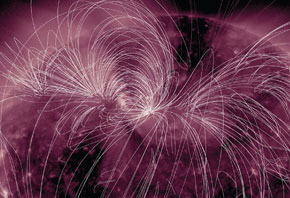
SDO / AIALines of the Sun’s magnetic fieldSDO / AIA
The last stage in the evolution of the life of approximately 98% of the stars in the Milky Way is to become a white dwarf, a degenerated celestial body, a slight flicker of light and small in size, although very dense. After losing the layers of their atmosphere and consuming all the hydrogen and helium in their nucleus, these old, decaying stars compress their mass into an area one million times smaller than their original dimension. The Sun, for example, should turn into a dying object with these features in six billion years. At least 15 thousand white dwarfs have been discovered in our galaxy. Therefore, it is no great novelty to find a new star in the sky in the final stages of its existence. However, the astrophysicist Kepler de Souza Oliveira Filho, from the Federal University of Rio Grande do Sul (UFRGS), achieved a small victory by finding, in a short amount of time, almost one thousand dying stars of a fairly rare kind, the so-called magnetic white dwarfs. “We discovered 900 such stars last year,” says the researcher from Rio Grande do Sul state. “Until then, we knew of 150 magnetic white dwarfs.” The finding has been announced at a scientific congress, but is yet to be published in specialist journals.
Generally, white dwarfs have no magnetic field. Because they are nearing their end, they have lost almost all the attributes of youth, including magnetism. However, a small number of them maintain this characteristic for unknown reasons. Moreover, this magnetism is not merely residual. The power of the magnetism of a white dwarf of this type may be millions and even billions of times greater than that of the Sun. The Sun’s average magnetic field is in the order of 1 Gauss, twice that of the Earth, with peaks of some thousands of Gauss in the areas in which the sunspots appear. Only neutron stars have a greater field than this white star variant. “The origin of the field has been a mystery since the first magnetic white dwarf was discovered in the 1970’s,” says the astrophysicist Dayal Wickramasinghe, from the Australian National University, one of the greatest experts in this type of celestial object. “It might be the fossil remains of the star’s preceding phases, it might have been generated during the stellar evolution process or it might have been produced recently by an active dynamo.” In astrophysics, the dynamo theory tries to explain why the Earth and the stars are capable of generating and maintaining magnetic activity for long periods.
Deviating from a path
Kepler discovered the unusual group of stars when he encountered a problem that caused him to deviate from the original aim of his study and that led him to the 900 white dwarfs. When he began studying data from the international Sloan Digital Sky Survey (SDSS), comprising 50 thousand stars that were white star candidates, he noticed something peculiar. Produced automatically by a software program often used by astrophysicists, the analysis of the so-called spectral emission lines of these stars – i.e., the graphs that show the photons released by the chemical elements in these objects – generated an unexpected result. The program indicated information errors in 40% of the SDSS sample of stars, an extremely high ratio. The UFRGS researcher became suspicious of these results and decided to check the quality of the data himself. He found an entirely anomalous pattern of emission lines in some stars, a deviation that could have been caused by a special type of white dwarf, the magnetic ones. “If I hadn’t checked on this manually, the software would never have found these stars,” says Kepler, who had the help of a UFRGS scientific initiation student, Ingrid Pelisoli, to conduct this task.

Gemini ObservatoryWhite dwarf: a degenerated star, which is dense and, in a few cases, magnetic as wellGemini Observatory
The magnetic white dwarfs triggered the interest of the Brazilian astrophysicist because they are stars whose mass is difficult to measure. “Their magnetic field is so strong that it distorts the atoms and makes it impossible to carry out this type of measurement accurately,” states Kepler. To determine the mass of white stars precisely was the initial objective of the researcher when he gained access to the SDSS data. Since 2007, Kepler has been trying to find white dwarfs as close as possible to the so-called Chandrasekhar limit, an idea put forth in the 1930’s. According to this law, formulated by the famous Indian theoretician Subrahmanyan Chandrasekhar (1910-1995), which led to his winning the Nobel Prize for Physics in 1983, a white star will only be stable if its mass is no more than 40% greater than that of the Sun. If it is greater than 1.4 times the Sun’s mass, it will suffer gravitational collapse and turn into a neutron star or a black hole.
There are plenty of issues that need to be clarified about this special type of white dwarf. “These objects provide us with a unique opportunity to understand the life of magnetic stars,” says the astrophysicist Baybars Külebi, from the University of Heidelberg, Germany, who will be collaborating with Kepler on the latter’s research into these mysterious celestial objects. “This is important, as the theory of stellar evolution doesn’t explain magnetism very well.” Despite the obstacles, the Brazilian researcher has not given up trying to determine the mass of magnetic white dwarfs. “We’ll test another method that uses the color of the star, rather than spectral emissions, to measure this parameter,” states Kepler.
Republish